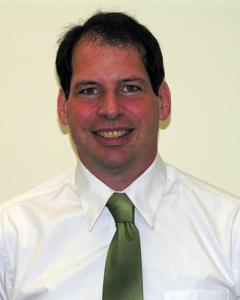Meet EPA Hydrologist Bill Shuster, Ph.D.

Advancing the Nation's "Green" Infrastructure
As a research hydrologist, EPA's Dr. Bill Shuster conducts interdisciplinary studies that integrate elements of hydrology, soil science, ecology, economics, and law to develop stormwater and wastewater management techniques.
His current work involves the design and testing of "green infrastructure" approaches to urban stormwater management, exploring residential and neighborhood-based technologies such as rain gardens and rain barrels, and how they may impart sustainability through social equity, economic stabilization, and environmental quality.
How does your science matter?
We have a tremendous problem with wastewater management in this country. During wet-weather events, our older combined sewer systems tend to overflow, sending polluted septic flows into our nation's rivers and streams.
My work matters because it is seeking solutions to that problem by helping us better understand what role green infrastructure—rain gardens, rain barrels, cisterns, urban soils in vacant lots, etc.—can play by absorbing and holding stormwater, reducing polluted runoff, and reduce sewer system overflows.
If you could have dinner with any scientist, past or present, who would it be and what would you like to ask them about?
I would have dinner with Linus Pauling or E.O. Wilson – I can't decide. I would love to get some insight into how they take their ideas and frame them into research questions, as well as how they would each approach a research problem. I use the word "consilience" with some frequency, and so I tip my hat to E.O. Wilson, and his great book by the same name.
What do you like most about your research?
What I enjoy most is spending time in the field, making measurements and engaging with my fellow citizens and their communities on the matters of soils, water, and wastewater management.
When did you first know you wanted to pursue science?
As a youth, I could reliably be found conducting chemistry experiments, some of which were scripted, many not; and taking apart radios.
What nailed it was that when I was seven years old (right about the time EPA was created), an instructor stopped me half-way through swim lesson tryouts to ask me why I had a test tube in my right hand. My answer: I was intent on taking a water sample!
Tell us about your science/educational background.
After I earned my BS in Physics from University of Michigan, Ann Arbor, I invested myself in learning the practice of agriculture, which after seven years of intensive fieldwork, led me to an interdisciplinary Ph.D. program in Environmental Science at The Ohio State University.
My doctoral research focused on how different kinds of earthworm communities affected the way that water and nutrients move through farm fields.
What brought you to EPA?
I am committed to public service, and it seemed plain to me that work as a scientist at EPA’s Office of Research and Development would be consistent with my vision for a career in environmental science.
If you were not a scientist, what do you think you would be doing?
I would be figuring out a way to use solar panels to power my Marshall amplifiers, and then go on a cross-country tour (in a vehicle powered by cooking oil), playing bass, and freaking people out with the crazy sounds from my old ARP 2600 synthesizer.
Any advice for students considering a career in science?
We need more scientists. Don't be afraid of math and ask for help when you need it (not everything I did in school came easy). Understand that without environmental quality, there is not a whole lot left to argue about. So, to the scientists of the future; your effort, energy, and creativity in the area of environmental science is sorely needed.
